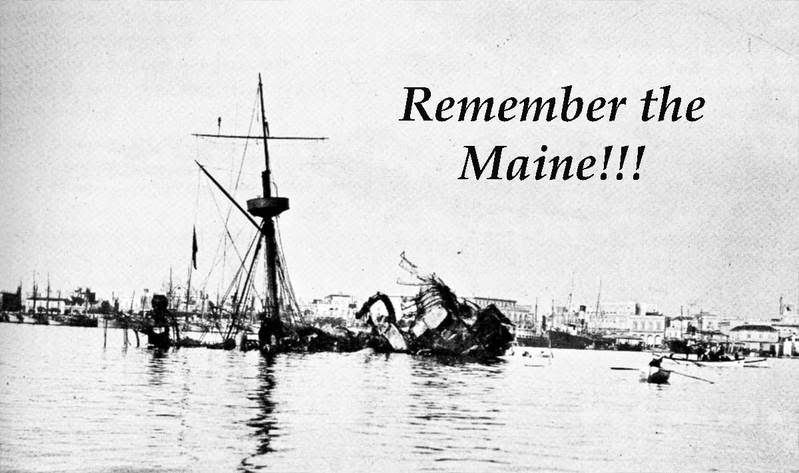![]()
February 18, 2013

"Remember the Maine..."
By Barbara Schock
At 9:40 p.m. on February 15, 1898, the USS Maine was sunk in Havana Harbor by an explosion. President William McKinley had dispatched the ship to protect American citizens and interests in Cuba where a revolution against Spain was underway. Of the 355 officers and men on board, only 94 survived. Two weeks later, a Navy investigation proclaimed an explosion in one of the forward compartments had been the cause of the sinking.
The Maine was the second commissioned battleship in the U.S. Navy. It was powered by steam and measured 324 feet in length. It had taken nine years to design and build the ship. Even so, it lacked sufficient armor and firepower. The ship was in use only three years before it was destroyed.
The American people had been incensed by reports the Spanish army had placed thousands of Cubans in concentration camps where many died of disease and malnutrition. They were outraged even more by the sinking of a Navy ship.
Newspaper publishers in New York did their utmost to encourage anger against Spain. Other newspapers reprinted some of those articles which were widely read by the American people, including Carl Sandburg. The rallying cry, “Remember the Maine” spread across the country.
Sandburg enlisted, with other Knox County men, in Company C, Sixth Illinois Infantry, on April 26th, just two days after the United States had declared war on Spain. He said he was 21 years old, but that wouldn’t happen until his next birthday. He was five feet, ten inches tall with grey eyes and brown hair.
There was a tremendous patriotic crowd at the Galesburg railroad depot to send off the 84 young men in Company C.. The first stop was at the fairgrounds in Springfield, Illinois. There, the men learned to drill and handle their weapons. Uniforms made of heavy wool were issued. They were similar to the garments worn by soldiers in the Civil War several decades earlier.
After being transferred to a camp outside Washington, DC, the young men were drilled some more. They were fed meager rations, lived in tents, washed their clothes in a stream and endured the stench of the nearby latrines. While on guard duty, Sandburg would recite to himself Grey’s “Elegy in a Country Church Yard,” to pass the time and keep himself awake.
Company C boarded a freighter captured from the Spanish on July 11th. They left from Charleston, South Carolina, and sailed to Guantanamo Bay, Cuba. Plans were changed and the company was landed on the south coast of Puerto Rico. Operations began July 25th. Each soldier carried a fifty pound pack. They walked up and down hills, tried to keep dry in the incessant rain and ate mostly beans and coffee. Young Sandburg lost twenty-two pounds during his time in the Army.
Because of poor management of the war, casualties were high. Of the 5,462 deaths during the campaign, 5,083 were due to disease. Yellow fever was endemic in Cuba and Puerto Rico. At times, 75 percent of the U.S. force was unfit for service.
By September 21, 1898, Co. C was back in Galesburg. They were feted at three banquets. The local newspaper noted “They bore the marks of great hardship and suffering.” Sandburg gave almost half of his mustering out pay to his father and started looking for a job.
He had kept a pocket notebook of his experiences, but they were only fragments of sentences. Perhaps they would be useful some day.
The Spanish-American War lasted only ten weeks, but it had a profound effect on the influence of the United States around the world. Spain lost its possessions in the Caribbean as well as the Philippine Islands in the Pacific Ocean.
Sandburg’s Hometown
February 18, 2013 - "Remember the Maine..."
February 11, 2013
- Lincoln's Birthday
February 4, 2013 -- Curiosity